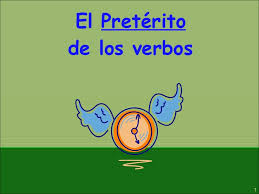 |
There are two past tenses in Spanish.
-The imperfect tense; Refer to actions in the past that occurred repeatedly EXAMPLE: I use to walk to school everyday.
-The preterite tense; Past accions that are completed EXAMPLE: I walked to school today.
We will focus only on the preterite today...
-er verbs
-ir verbs
Procedure Example
bailer= to dance
-er and -ir verbs
comer= to eat
Example of -ir verb
escribir= to write
-The imperfect tense; Refer to actions in the past that occurred repeatedly EXAMPLE: I use to walk to school everyday.
-The preterite tense; Past accions that are completed EXAMPLE: I walked to school today.
We will focus only on the preterite today...
- Remember there are three types of verbs
-er verbs
-ir verbs
Procedure Example
- Identify the
verb
Hablar= to speak
- Drop the ending Habl
- Choose a
subject
Yo= I
- Add the new ending Yo Hablé= I spoke
- Don't forget that each verb needs a subject. The
subject pronouns work the same way that they work in the present
tense.
| Yo |
Nosotros Nosotras |
| Tú |
Vosotros Vosotras |
| Él Ella Usted |
Ellos Ellas Ustedes |
- Do you remember what the subject pronouns mean? Test yourself!
- New verb endings
-
é
amos
aste
asteis
ó
aron
bailer= to dance
| bailé |
bailamos |
| bailaste |
bailasteis |
| bailó |
bailaron |
-er and -ir verbs
-
*note that both -er and -ir endings are the sameí
imos
iste
isteis
ió
ieron
comer= to eat
| comí |
comimos |
| comiste |
comisteis |
| comió |
comieron |
Example of -ir verb
escribir= to write
| escribí |
escribimos |
| escribiste |
escribisteis |
| escribió |
escribieron |
| Los Objectivos |
La Presentación del pretérito |
La Atención |
La Construcción |
La Extensión |
El Video |